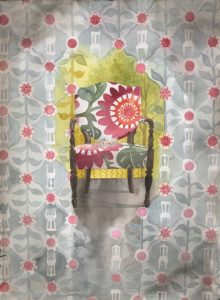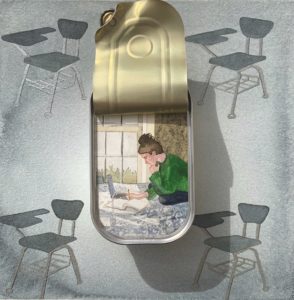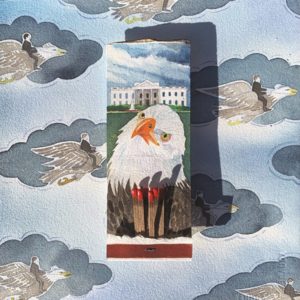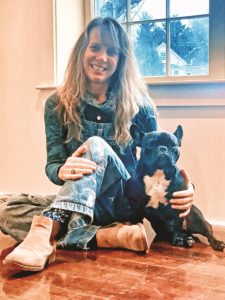By Susannah Elisabeth Fulcher
“When will this end? When will we go back to normal? When will we see each other again? These are questions we’ve been asking ourselves since the beginning of this pandemic,” says Traci Harmon-Hay. The word when, she adds, invites reflection on the future and the past — “Remember when we went on a vacation as a family? Remember when we were able to spend time with friends outside our pod?”
Inspired by the upcoming anniversary on March 13 — that fateful Friday in 2020 when the Covid lockdown began — Harmon-Hay decided to do a pop-up exhibit titled “When.” She invited two fellow local artists, Megan Hinton and Susie Nielsen, to join her in showing work created during the pandemic.
Both responded with immediate enthusiasm. “I have learned a lot in this last year,” Nielsen says, “and making work for this show gave me room to really reflect and make sense of it.”

Harmon-Hay, who ran the Harmon Gallery on Commercial Street in Wellfleet from 2000 to 2014 (it’s been run since then by artist Vincent Amicosante, who recently announced its closing), knew that she wanted to structure this exhibit differently from a traditional gallery show.
“Covid has given us the opportunity to think outside the box, not just creatively, but also about how art is represented and exhibited,” she says. “ ‘When’ is a not-for-profit show created simply for observation and reflection. It is an opportunity for our community to get out and gather safely.”
The exhibit will take place on Saturday, March 13 and Sunday, March 14 (and the following weekend) in the space at 95 Commercial St. in Wellfleet recently vacated by the Quiet Mind yoga studio. Upon entering, visitors will circle around a sculptural piece by Hinton, Work Tilt, and view artworks “without the distraction of price tags and wine,” Harmon-Hay says.
Harmon-Hay feels that Hinton’s work, which she describes as brave, takes “a leap into places of deep contemplation.” Hinton, in an email, explains how it came about: “With the notion of mortality on the line, I felt permission to work from an interior experience,” using discarded art and trashed objects to reflect on “what’s important collectively — our hardship, survival, and triumph over this past year.”

While the artworks on view differ in style and media, they complement one another. Nielsen says that she enjoyed “this sense of collaboration in working on a common concept.” Nielsen’s pieces, Harmon-Hay says, “exude a ghostlike veil of mystery. Using words, shapes, and designs, she gives hints of a message she wants the viewer to see and guess.”
Harmon-Hay’s own paintings tell a story “outside the norm of how things have always been,” she says. One piece shows her daughter schooling remotely on her bed, inside an open can, against a wallpaper of student desks. It revives a series of can assemblages she did in 2012.
“The can, for me, is a symbol of confinement,” Harmon-Hay says. “I stuff the can with a message in the form of a painting, then place it on a background portraying the rest of the message. The two play off one another as ‘inside’ and ‘outside.’ ”
She also revived a series of small “matchbox” assemblages from 2011 to explore the notions of caution, safety, and danger. One of these pieces — Really? — presents a bald eagle before the White House in a matchbook.

Harmon-Hay worked on a series of larger paintings of empty chairs or “thrones” during the pandemic. One includes a Covid-19 image in a wallpaper design. “A chair symbolizes being indoors — sitting and just thinking or remembering,” Harmon-Hay says.
Harmon-Hay got her B.F.A. in illustration and painting from the Maryland Institute of Art, and studied with Fritz Briggs of the Schuler School of Fine Arts in Baltimore. “My work is very narrative,” she says. “I’ve always felt that if I can combine art with where I am in my life, I can tell a story.”
After school, Harmon-Hay worked freelance on commercial projects, but soon realized it wasn’t the life she wanted for herself. “I got so tired of the commercial side of art, so I decided just to be an artist and paint,” she says.
On her own at 25, she moved to Wellfleet. “I fell in love with this place like I’d never been in love before, and I knew that I needed to be here,” she says. “I went into the Left Bank Gallery with my portfolio, and Audrey Parent told me she would show my work. She also offered me a job, so she really made it possible for me to stay here, and, for that, I will always be grateful.”

After working for Parent for seven years and running her own gallery for the next 14, Harmon-Hay is now focusing solely on painting and teaching workshops at the Provincetown Art Association and Museum, Truro Center for the Arts at Castle Hill, and privately.
Organizing this exhibit has been an extraordinary experience. “I’ve never worked this hard on an event that I will present just to the immediate community,” she says. “I mean, who has an art opening in the middle of March?” She laughs. “If it wasn’t for Covid, this show would not be happening. As artists, we feel the responsibility to bring people hope, to show them that there is still beauty out there, to present art that makes them think and feel. That is what this is about.”
Covid Trifecta
The event: “When: An Exhibition Marking One Year of the Pandemic,” featuring artwork by Traci Harmon-Hay, Megan Hinton, and Susie Nielsen
The time: Noon to 5 p.m. on Saturday, March 13 and Sunday March 14; Saturday, March 20 and Sunday, March 21
The place: 95 Commercial St., Wellfleet
The cost: Free



